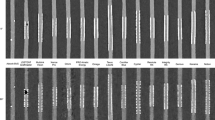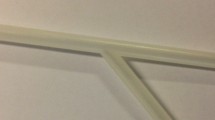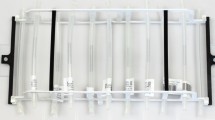Abstract
Introduction
The aim of the study was to examine the ability of a 64-slice MDCT to detect in-stent stenoses in an ex vivo model of coronary stents.
Methods
Five different stents (Liberté™, Boston Scientific; Driver®, Medtronic; Multi-Link Vision®, Guidant; Taxus® Express®, Boston Scientific; Cypher®, Cordis) were examined using a dynamic cardiac phantom. The stents were pulled over a vessel model that consists of a polymer tube with diameters of 3.0, 3.5, and 4.0 mm and four different degrees of stenoses (0%; 30%; 50%; 70–80%). This model was moved with a rate of 60 bpm to mimic cardiac motion. To assess the degree of artificial signal reduction (artificial reduction of attenuation (ARA)) by the different stents, attenuation values were measured in the vessel outside the stent, and in the non-stenotic vessel inside the stent. Furthermore the grade of stenosis was assessed by two clinical observers.
Results
Highest ARA was found for the Cypher® Stent (35 HU), whereas the Liberté™ Stent presented the lowest ARA (16 HU). Depending on the stent and the vessel diameter, up to 87.5% of the stenoses were correctly diagnosed. In the 3.0 and 3.5 mm vessels, a nonstenotic or low-grade stenotic vessel was diagnosed as intermediate or high-grade stenosis in 22.5%, whereas in the 4.0 mm vessels, this kind of overestimation did not occur. A 50% stenosis was diagnosed as a 30% stenosis in 30%. On the other hand, highgrade stenoses were underestimated in only 10%. On a fourpoint scale, the average deviation from the real grade of stenosis was 0.21 for the Liberté™ stent, 0.54 for the Taxus® Express® stent, 0.29 for Driver® stent, 0.62 for the Multi-Link Vision® stent, and 0.37 for the Cypher™ stent.
Conclusions
In a dynamic cardiac phantom model, high grade stenoses in vessels with a diameter of 4 mm could be reliably detected irrespective of the stent type used in this study. Vice versa, high grade stenoses (≥50%) could only be ruled out with certainty in vessels with a diameter of 4 mm. In smaller vessels, the ability to correctly diagnose high-grade stenoses was dependent on the type of stent and the imaging artifacts associated with it.
Similar content being viewed by others
References
Topol EJ (1998) Coronary-artery stents–gauging, gorging, and gouging. N Engl J Med 339:1702–1704
Elsasser A, Mollmann H, Nef HM, Hamm CW (2006) How to revascularize patients with diabetes mellitus: bypass or stents and drugs? Clin Res Cardiol 95:195–203
Kammler J, Hofmann R, Steinwender C, Kypta A, Leisch F (2006) Simultaneous angiographic late stent thrombosis in two different coronary vessels after withdrawal of the combined anti-platelet therapy. Clin Res Cardiol 95:560–564
Khattab AA, Hamm CW, Senges J et al (2007) Incidence and predictors of target vessel revascularization after sirolimus-eluting stent treatment for proximal left anterior descending artery stenoses among 2274 patients from the prospective multicenter German Cypher Stent Registry. Clin Res Cardiol 96:279–284
Beier F, Gyongyosi M, Raeder T et al (2006) First in-human randomized comparison of an anodized niobium stent versus a standard stainless steel stent–an intravascular ultrasound and angiographic two-center study: the VELA study. Clin Res Cardiol 95:455–460
Cademartiri F, Marano R, Runza G et al (2005) Non-invasive assessment of coronary artery stent patency with multislice CT: preliminary experience. Radiol Med (Torino) 109:500–507
Hong C, Chrysant GS, Woodard PK, Bae KT (2004) Coronary artery stent patency assessed with in-stent contrast enhancement measured at multi- detector row CT angiography: initial experience. Radiology 233:286–291
Kitagawa T, Fujii T, Tomohiro Y et al (2006) Noninvasive assessment of coronary stents in patients by 16-slice computed tomography. Int J Cardiol 109:188–194
Kruger S, Mahnken AH, Sinha AM et al (2003) Multislice spiral computed tomography for the detection of coronary stent restenosis and patency. Int J Cardiol 89:167–172
Mahnken AH, Buecker A, Wildberger JE et al (2004) Coronary artery stents in multislice computed tomography: in vitro artifact evaluation. Invest Radiol 39:27–33
Maintz D, Seifarth H, Flohr T et al (2003) Improved coronary artery stent visualization and in-stent stenosis detection using 16-slice computed- tomography and dedicated image reconstruction technique. Invest Radiol 38:790–795
Mohlenkamp S, Pump H, Baumgart D et al (1999) Minimally invasive evaluation of coronary stents with electron beam computed tomography: In vivo and in vitro experience. Catheter Cardiovasc Interv 48:39–47
Pump H, Moehlenkamp S, Sehnert C et al (1998) Electron-beam CT in the noninvasive assessment of coronary stent patency. Acad Radiol 5:858–862
Pump H, Mohlenkamp S, Sehnert CA et al (2000) Coronary arterial stent patency: assessment with electronbeam CT. Radiology 214:447–452
Seifarth H, Raupach R, Schaller S et al (2005) Assessment of coronary artery stents using 16-slice MDCT angiography: evaluation of a dedicated reconstruction kernel and a noise reduction filter. Eur Radiol 15:721–726
Mohaved MR (2006) Six-months patency of three long drug eluting stents documented by surveillance coronary multi-detector computed tomography (MDCT). Clin Res Cardiol 95:605–609
Schroeder S, Kopp AF, Baumbach A et al (2001) Noninvasive detection and evaluation of atherosclerotic coronary plaques with multislice computed tomography. J Am Coll Cardiol 37:1430–1435
Ulzheimer S, Kalender WA (2003) Assessment of calcium scoring performance in cardiac computed tomography. Eur Radiol 13:484–497
Maintz D, Seifarth H, Raupach R et al (2006) 64-slice multidetector coronary CT angiography: in vitro evaluation of 68 different stents. Eur Radiol 16:818–826
Seifarth H, Ozgun M, Raupach R et al (2006) 64-Versus 16-slice CT angiography for coronary artery stent assessment: in vitro experience. Invest Radiol 41:22–27
Mahnken AH, Muhlenbruch G, Seyfarth T et al (2006) 64-slice computed tomography assessment of coronary artery stents: a phantom study. Acta Radiol 47:36–42
Oncel D, Oncel G, Karaca M (2007) Coronary stent patency and in-stent restenosis: determination with 64-section multidetector CT coronary angiography– initial experience. Radiology 242:403–409
Rixe J, Achenbach S, Ropers D et al (2006) Assessment of coronary artery stent restenosis by 64-slice multi-detector computed tomography. Eur Heart J 27:2567–2572
Van Mieghem CA, Cademartiri F, Mollet NR et al (2006) Multislice spiral computed tomography for the evaluation of stent patency after left main coronary artery stenting: a comparison with conventional coronary angiography and intravascular ultrasound. Circulation 114:645–653
Author information
Authors and Affiliations
Corresponding author
Rights and permissions
About this article
Cite this article
Schlosser, T., Scheuermann, T., Ulzheimer, S. et al. In vitro evaluation of coronary stents and in-stent stenosis using a dynamic cardiac phantom and a 64-detector row CT scanner. Clin Res Cardiol 96, 883–890 (2007). https://doi.org/10.1007/s00392-007-0564-2
Received:
Accepted:
Published:
Issue Date:
DOI: https://doi.org/10.1007/s00392-007-0564-2




